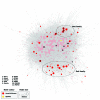IQGAP1 is a key node within the small GTPase network
- PMID: 24355937
- PMCID: PMC4011815
- DOI: 10.4161/sgtp.27451
IQGAP1 is a key node within the small GTPase network
Abstract
Coordination of the activity of multiple small GTPases is required for the regulation of many physiological processes, including cell migration. There are now several examples of functional interplay between small GTPase pairs, but the mechanisms that control GTPase activity in time and space are only partially understood. Here, we build on the hypothesis that small GTPases are part of a large, integrated network and propose that key proteins within this network integrate multiple signaling events and coordinate multiple small GTPase activities. Specifically, we identify the scaffolding protein IQGAP1 as a master regulator of multiple small GTPases, including Cdc42, Rac1, Rap1, and RhoA. In addition, we demonstrate that IQGAP1 promotes Arf6 activation downstream of β1 integrin engagement. Furthermore, following literature-curated searches and recent mass spectrometric analysis of IQGAP1-binding partners, we report that IQGAP1 recruits other small GTPases, including RhoC, Rac2, M-Ras, RhoQ, Rab10, and Rab5, small GTPase regulators, including Tiam1, RacGAP1, srGAP2 and HERC1, and small GTPase effectors, including PAK6, N-WASP, several sub-units of the Arp2/3 complex and the formin mDia1. Therefore, we propose that IQGAP1 acts as a small GTPase scaffolding platform within the small GTPase network, and recruits and/or regulates small GTPases, small GTPase regulators and effectors to orchestrate cell behavior. Finally, to identify other putative key regulators of small GTPase crosstalk, we have assembled a small GTPase network using protein-protein interaction databases.
Keywords: IQGAP1; Ras GTPases; signal transduction; small GTPase crosstalk; small GTPase network.
Figures




Similar articles
-
CD13 tethers the IQGAP1-ARF6-EFA6 complex to the plasma membrane to promote ARF6 activation, β1 integrin recycling, and cell migration.Sci Signal. 2019 Apr 30;12(579):eaav5938. doi: 10.1126/scisignal.aav5938. Sci Signal. 2019. PMID: 31040262 Free PMC article.
-
The interplay between IQGAP1 and small GTPases in cancer metastasis.Biomed Pharmacother. 2021 Mar;135:111243. doi: 10.1016/j.biopha.2021.111243. Epub 2021 Feb 1. Biomed Pharmacother. 2021. PMID: 33434854 Review.
-
Rac1 is deactivated at integrin activation sites through an IQGAP1-filamin-A-RacGAP1 pathway.J Cell Sci. 2013 Sep 15;126(Pt 18):4121-35. doi: 10.1242/jcs.121988. Epub 2013 Jul 10. J Cell Sci. 2013. PMID: 23843620 Free PMC article.
-
ADP-ribosylation factor 6 regulates glioma cell invasion through the IQ-domain GTPase-activating protein 1-Rac1-mediated pathway.Cancer Res. 2009 Feb 1;69(3):794-801. doi: 10.1158/0008-5472.CAN-08-2110. Epub 2009 Jan 20. Cancer Res. 2009. PMID: 19155310 Free PMC article.
-
New model for the interaction of IQGAP1 with CDC42 and RAC1.Small GTPases. 2020 Jan;11(1):16-22. doi: 10.1080/21541248.2017.1321169. Epub 2017 Jun 19. Small GTPases. 2020. PMID: 28622072 Free PMC article. Review.
Cited by
-
The IQGAP scaffolds: Critical nodes bridging receptor activation to cellular signaling.J Cell Biol. 2023 Jun 5;222(6):e202205062. doi: 10.1083/jcb.202205062. Epub 2023 Apr 18. J Cell Biol. 2023. PMID: 37071417 Free PMC article. Review.
-
Adenomatous Polyposis Coli (APC) in cell migration.Eur J Cell Biol. 2022 Jun-Aug;101(3):151228. doi: 10.1016/j.ejcb.2022.151228. Epub 2022 Apr 22. Eur J Cell Biol. 2022. PMID: 35483122 Free PMC article. Review.
-
Tight junction protein cingulin variant is associated with cancer susceptibility by overexpressed IQGAP1 and Rac1-dependent epithelial-mesenchymal transition.J Exp Clin Cancer Res. 2024 Mar 1;43(1):65. doi: 10.1186/s13046-024-02987-z. J Exp Clin Cancer Res. 2024. PMID: 38424547 Free PMC article.
-
CD13 tethers the IQGAP1-ARF6-EFA6 complex to the plasma membrane to promote ARF6 activation, β1 integrin recycling, and cell migration.Sci Signal. 2019 Apr 30;12(579):eaav5938. doi: 10.1126/scisignal.aav5938. Sci Signal. 2019. PMID: 31040262 Free PMC article.
-
Inter-kingdom Signaling by the Legionella Quorum Sensing Molecule LAI-1 Modulates Cell Migration through an IQGAP1-Cdc42-ARHGEF9-Dependent Pathway.PLoS Pathog. 2015 Dec 3;11(12):e1005307. doi: 10.1371/journal.ppat.1005307. eCollection 2015 Dec. PLoS Pathog. 2015. PMID: 26633832 Free PMC article.
References
-
- Takai Y, Sasaki T, Matozaki T. Small GTP-binding proteins. Physiol Rev. 2001;81:153–208. - PubMed
Publication types
MeSH terms
Substances
Grants and funding
LinkOut - more resources
Full Text Sources
Other Literature Sources
Molecular Biology Databases
Research Materials
Miscellaneous
